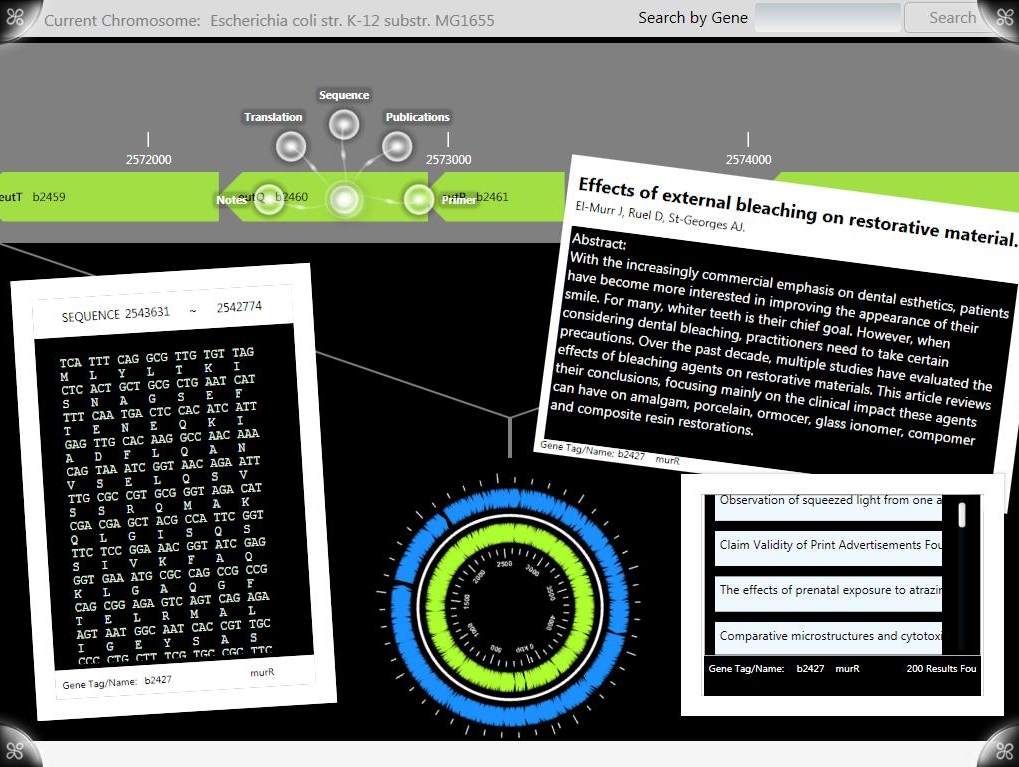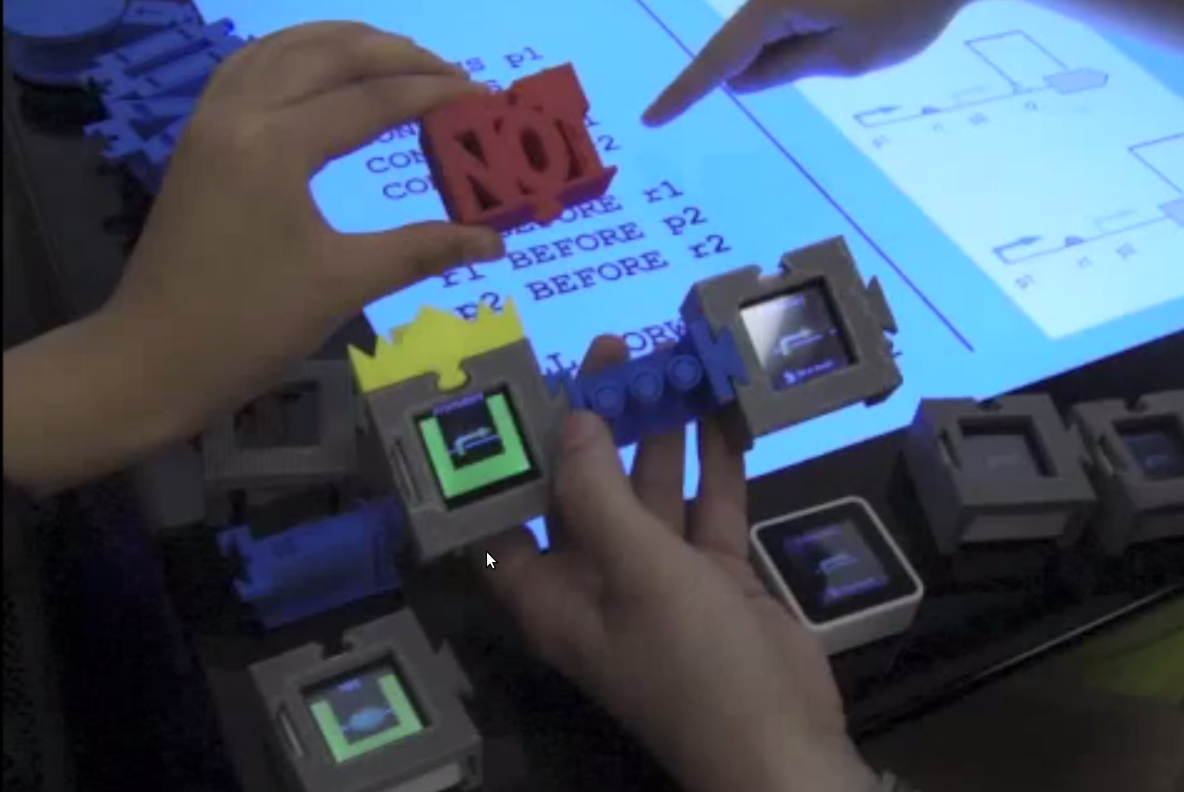Synbiosis: Advancing Innovation in Bio-Design through Reality Based Interaction






Orit Shaer, Johanna Okerlund, Casey Grote, Evan Segreto, Lily Chen, Grace Hu, Claire Schlenker, Joanna Bi
2013 Team:
Orit Shaer, Consuelo Valdes, Diana Eastman, Tiffany Chen, Catherine Guo, Casey Grote, Heather Petrow, Joanna Bi, Cassie Hoef, Evan Segreto, Sravanti Tekumalla, Daniel Worstell
2012 Team:
Orit Shaer, Consuelo Valdes, Chelsea Hoover, Kimerberly Chang, Kathy Liu, Nahum Seifeselassie, Wendy Xu, Nicole Francisco, Linda Ding, Casey Grote, Kara Lu, Veronica Lin
2011 Team:
Orit Shaer, Douglas Densmore, Traci Haddock, Swapnil Bhatia, Suma Jaini, Megan Strait, Craig LaBoda, Michael Lintz, Consuelo Valdes, Heidi Wang, Taili Feng, Janoo Fernandez, Michelle Ferreirae, Chenkai Liu, Jenhan Tao, Kelsey Tempel, Kathy Liu, Casey Grote, Margaux Canevari, Shannon Harrington, Kyle Jones, Evelyn Orozco, Alberto Purwada, Vanessa Yanez
Publications:
- O. Shaer, A. Mazalek, J. Okerlund, C. Grote, B. Ullmer Tangible Interaction With Large Data Sets Using Active Tokens Exploring the Challenges of Making Data Physical Workshop, CHI 2015
- G. Hu, O. Shaer, L. Chen, J. Okerlund Exploring the Use of Google Glass in Wet Laboratories WIP CHI 2015 Computer-Human Interaction
- C. Grote, E. Segreto, J. Okerlund, R. Kincaid, O. Shaer. Eugenie: Multi-Touch and Tangible Interaction for Bio-Design. Proc. TEI 2015 Tangible, Embedded and Embodied Interation.
- C. Grote, E. Segreto, J. Okerlund, R. Kincaid, O. Shaer, Eugenie: Gestural and Tangible Interaction with Active Tokens for Bio-Design, Extended Abstract, ACM UIST 2014.
- O. Shaer, C. Valdes, S. Liu, K. Lu, K. Chang, W. Xu, T. L. Haddock, S. Bhatia, D. Densmore, R. Kincaid. Designing Reality-Based Interfaces for Experiential Bio-Design, Personal and Ubiquitous Computing, November 2013.
- O. Shaer, C. Valdes, S. Liu, K. Lu, T. L. Haddock, S. Bhatia, D. Densmore, R. Kincaid. MoClo Planner: Interactive Visualization for Modular Cloning Bio-Design, IEEE BioVis 2013.
- Hoef C, Worstell D, Shaer O. zTree: Interactive 3D Visualization of Combinatorial DNA Libraries. Poster presented at BioVis. 3rd IEEE Symposium on Biological Data Visualization; 2013 October 13-14; Atlanta, Georgia.
- K. Chang, W. Xu, N. Francisco, C. Valdes, R. Kincaid, R. Shaer. SynFlo: An Interactive Installation Introducing Synthetic Biology Concepts. ITS'2012, November 2012
- W. Xu, K. Chang, N. Francisco, C. Valdes, R. Kincaid, O. Shaer, From Wet Lab Bench to Tangible Virtual Experiment: SynFlo , Extended abstract, ACM SIGCHI TEI 2013 Tangible, Embedded and Embodied Interaction.
- S. Liu, K. Lu, N. Seifeselassie, C. Grote, N. Francisco, V. Lin, L. Ding, C. Valdes, R. Kincaid, O. Shaer, MoClo Planner: Supporting Innovation in Bio-Design through Multitouch Interaction, Demo abstract, ACM ITS 2012 Interactive Tabletops and Surfaces.
- K. Chang, W. Xu, N.Francisco, C. Valdes, R. Kincaid, O.Shaer, SynFlo: An Interactive lnstallation Introducing Synthetic Biology Concepts, Demo abstract, ACM ITS 2012 Interactive Tabletops and Surfaces.
Media:
-
iGEM 2012 wiki page:
Projects won Gold medal at Regionals,and Best SBOL-Based Tool, Best Eugene-Based Design, and Best Requirements Engineering at World Championship Competition. -
Wellesley College News:
Wellesley Scores Big at International Synthetic Biology Competition -
iGEM 2011 wiki page:
Project won both Gold Medal and Best Software Project Award. -
BU News:
BU-Wellesley Software Wins Gold at iGEM Americas Regional Jamboree. October 21, 2011 -
IEEE: Robotics & Automation Magazine:
Engineering from Prank to Product. September, 2011
Project Brief:
Synthetic biology will require a multidisciplinary, collaborative design environment in order to engineer the complex biological systems of the future. Our teams created a collection of software tools which address specific technical synthetic biology challenges while simultaneously advancing the way in which users interact with computing environments.
Our 2011 software workflow comprises of "G-nome Surfer Pro" for research, "Trumpet" and "Optimus Primer" for design, and"Puppetshow" and "eLabNotebook" for the construction of those designs. In addition, we also incorporate wetlab experimentationinto our project to apply these tools to create novel biological systems to investigate Tuberculosis.
The 2012 software suite includes the "MoClo Planner" for mediation of the Golden Gate Molecular Cloning process, "SynBio Search" for genetic research and planning, and "SynFlo" for the interactive exposure of basic synthetic biology concepts to students.
Our 2013 focused on supporting collaborative top-down bio-design with an integrated development environment and a visual programming langage "Eugenie". We also explored 3D visualization of combinatorial DNA libraries with "zTree". With "Bac to the Future" we seek to communicate core ideas in synthetic biology to non-scientists in informal learning environments. The combination of human computer interaction, bio-design automation, and experimental design makes our effort unique in the iGEM experience and closes the loop on the design-build-test methodology.
Our work in 2014 began to incorporate new technologies into the bio-design workflow with active tangibles in "Eugenie++," a system which makes use of the Microsoft Pixelsense, Sifteo cubes and 3d printed constraints. Using Google Glass we also began to investigate supporting wetlab work with gestural interaction and wearable tech.
From 2015 to 2017 our focus shifted to a museum setting. In addition to expanding SynFlo into this new space, we developed BacPack for New Fronteirs, an interactive museum exhibit that introduces core synthetic biology concepts to visitors through tangible and multi-touch interactions that bridge size and time scales. The exhibit engages users in the design and engineering of bacteria, which are helpful in extreme environments like Mars.




